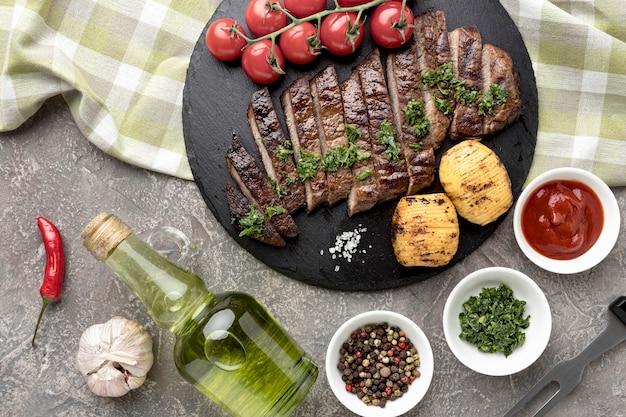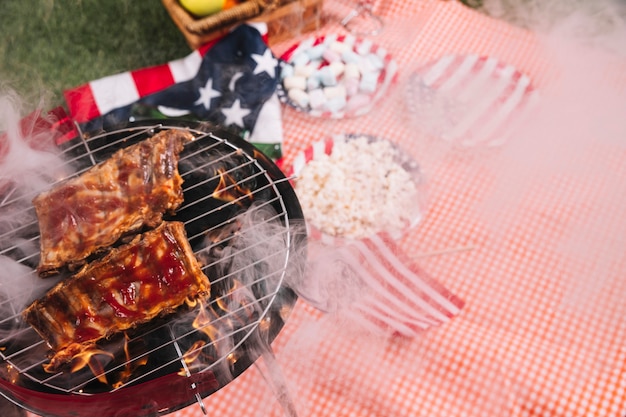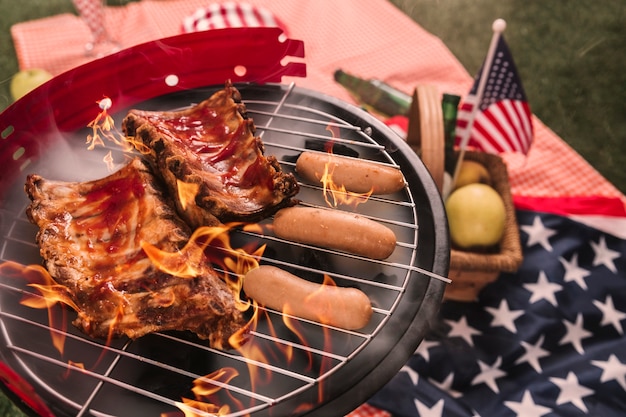(Part 1) Understanding steak doneness

First things first, let's clear something up – there's no right or wrong when it comes to how you like your steak cooked. It's all about personal preference! But, knowing the different levels of doneness is crucial for achieving your desired results. And trust me, there's a whole spectrum of textures and flavors to discover!
Rare
Think of a rare steak as a juicy, crimson centre with a thin layer of cooked surface. It's still incredibly soft and practically melts in your mouth. The meat should be warm to the touch, not cold. The inside will be cool, but the exterior will be hot. This is how I prefer my steak – a touch of pink in the centre is just heavenly! It's a true testament to the quality of the meat, showcasing its natural flavors and tenderness.
Medium Rare
This is probably the most popular doneness – that perfect balance of flavour and tenderness. The centre of the steak will have a bit more colour than rare, with a slightly firmer texture. It's still pretty juicy though, and it's my go-to for most occasions. You'll notice a distinct transition from the cooked exterior to the slightly pink center, creating a captivating contrast in both texture and taste.
Medium
Moving towards a more well-done texture, medium steak has a more pronounced brown colour throughout. The centre still has a faint hint of pink, but it's definitely firming up. The texture is more consistent throughout the steak, with a less dramatic contrast between the exterior and interior. Some people find this the ideal level of doneness for achieving a more balanced flavor profile.
Medium Well
Medium well is where the pink starts to fade, with a mostly brown interior. The texture is firmer than medium, but it's still juicy enough to enjoy. This is a good option for those who want a steak with a bit more "bite" to it, but still retain some moisture.
Well Done
This is for those who prefer their steak with no trace of pink. It's fully cooked through, with a firm and dry texture. While it might not be my personal preference, it's all about individual taste, right? If you like your steak well done, go for it! Just be aware that it will be the least juicy and tender option.
(Part 2) Choosing the Perfect Cut of Steak

The cut of steak you choose will heavily influence how it cooks and how it tastes. Some cuts are known for their marbling, others for their tenderness, and others for their distinct flavors. Here are a few of my favourites:
Ribeye
Oh, ribeye. It's a classic for a reason! With its rich marbling and beautiful flavour, it's sure to impress. The marbling, those streaks of fat throughout the meat, create an incredible juiciness and tenderness that melts in your mouth. It's best grilled over medium heat to allow the fat to render beautifully, resulting in a rich, flavorful sauce that coats the steak. Remember to trim any excess fat before grilling to prevent flare-ups on your grill.
new york strip
Known for its leaner cut with a good amount of marbling, the New York Strip is perfect for those who enjoy a steak with a bit more chew. The leaner profile gives it a more pronounced flavor, and the marbling ensures it stays juicy and flavorful. It holds up well to grilling and develops a fantastic crust, making it a great choice for those who appreciate a good sear.
Sirloin
Another lean option, sirloin is a great value for money. It's a versatile cut that can be grilled, pan-fried, or even baked. It's a good choice for those who prefer a leaner, more delicate flavour. It's also a great cut for grilling over direct heat, as it cooks quickly and evenly.
filet mignon
Filet mignon is a real treat. It's known for its incredible tenderness and buttery flavour. This is the most tender cut of steak, and it's often grilled to medium-rare or rare as it can dry out quickly if cooked longer. Treat yourself to a nice thick filet for a truly special occasion.
Tenderloin
Don't be fooled by the name! Tenderloin is the same cut as filet mignon, but it's often sold in a larger piece. It's perfect for sharing or slicing into beautiful medallions. You can grill it whole, or you can slice it into medallions and grill them individually.
(Part 3) Essential Tools for a Successful Steak Grill

Before we get to the actual grilling, let's talk about the tools of the trade. A few key items will make your steak grilling experience much smoother and more enjoyable. You don't need a fancy setup, just the right essentials:
- A good quality grill: Whether you're using gas or charcoal, a well-maintained grill is essential. Ensure it's clean and preheated to the right temperature. If you're using a gas grill, make sure the burners are evenly distributed to ensure consistent heat. If you're using a charcoal grill, use high-quality charcoal and let it burn until it's covered in a thin layer of ash, indicating it's ready for grilling.
- meat thermometer: This is the key to achieving perfect doneness. Trust me, you don't want to overcook your steak! It's the only way to ensure your steak is cooked to your liking, especially if you're new to grilling. A meat thermometer takes the guesswork out of grilling and allows you to achieve consistent results every time.
- Grill tongs: For safely flipping your steak without piercing the meat. You want to avoid losing those precious juices. Choose tongs with a good grip and long handles to keep your hands away from the heat.
- Grill brush: Keeps your grill clean and prevents sticking. A clean grill will not only prevent your steak from sticking, but it will also help you achieve those beautiful grill marks.
- Seasoning: Don't underestimate the power of good seasoning. Salt and pepper are the basics, but get creative with your spice blends! You can use pre-made spice blends, or you can create your own by combining different herbs and spices. Some popular options include garlic powder, onion powder, paprika, chili powder, and cumin.
(Part 4) Prepping Your Steak
Okay, you've got your steak and your tools. Now it's time to get ready for the actual grilling. Here's what I do to make sure my steak is perfectly prepped:
- Pat the steak dry: This helps create a good sear and prevents steaming, which can lead to a tough texture. A dry steak will sear more quickly and evenly, creating a crispy crust and locking in the juices.
- Season generously: Salt and pepper are my go-to, but feel free to experiment with other spices. Just remember to season liberally – you can always add more later. Seasoning your steak before grilling allows the flavors to penetrate the meat, resulting in a more flavorful steak.
- Let the steak come to room temperature: This helps the steak cook more evenly. Aim for about 30 minutes at room temperature. A steak that is cold from the fridge will cook unevenly, as the outside will cook faster than the inside. Bringing it to room temperature allows the internal temperature to rise gradually, resulting in a more evenly cooked steak.
(Part 5) Mastering the Grill
Now for the fun part - the actual grilling! Here's how to get those beautiful grill marks and a perfectly cooked steak.
Hot and Fast Grilling
This is my preferred method for achieving a juicy, flavorful steak with a crispy crust. It's all about searing the steak quickly over high heat, creating a flavorful crust and locking in the juices. Here's the breakdown:
- Preheat your grill to high heat: You want the grates nice and hot for a good sear. If you're using a gas grill, set the burners to high heat. If you're using a charcoal grill, use a good amount of charcoal and let it burn until it's covered in a thin layer of ash.
- Place the steak directly over the heat: Aim for 3-4 minutes per side for a nice sear. You want to see beautiful grill marks forming on the steak. The steak should be sizzling and releasing a fragrant aroma.
- Flip the steak and continue grilling: You can grill the steak directly over the high heat for the remainder of the time, or you can move it to a cooler part of the grill to finish cooking. If you're using a gas grill, you can turn down the heat to medium-high. If you're using a charcoal grill, you can move the steak to a less hot part of the grill.
- Check for doneness: Use a meat thermometer to ensure your steak is cooked to your liking. Insert the thermometer into the thickest part of the steak, making sure to avoid touching any bone.
Slow and Low Grilling
If you're after a more tender steak with a slightly less pronounced sear, slow and low grilling is a great option. This method is ideal for thicker cuts of steak, as it allows the meat to cook more evenly without drying out. Here's how to do it:
- Preheat your grill to medium heat: Aim for a temperature around 350-400 degrees F (175-200 degrees C). You want a consistent, moderate heat that will cook the steak slowly and evenly.
- Place the steak on the grill and cook slowly: This will take longer, but it allows the steak to cook more evenly and stay juicy. You can use a grill thermometer to monitor the temperature.
- Check for doneness: Use a meat thermometer to monitor the internal temperature. You'll need to check the temperature more frequently with this method, as the steak will cook more slowly.
(Part 6) Timing Guide for Perfect Steak
Right, here's the part we've all been waiting for – the timing guide! It's important to remember that these are just guidelines. The exact cooking time will depend on the thickness of your steak and the heat of your grill. But, it's a good starting point to get you in the right ballpark.
| Doneness | Internal Temperature | Approximate Time (1-inch steak) |
|---|---|---|
| Rare | 125-130 degrees F (52-54 degrees C) | 2-3 minutes per side |
| Medium Rare | 130-135 degrees F (54-57 degrees C) | 3-4 minutes per side |
| Medium | 140-145 degrees F (60-63 degrees C) | 4-5 minutes per side |
| Medium Well | 150-155 degrees F (65-68 degrees C) | 5-6 minutes per side |
| Well Done | 160 degrees F (71 degrees C) and above | 6-7 minutes per side |
Remember to adjust the cooking time for thicker steaks. And always use a meat thermometer for the most accurate results!
(Part 7) Resting Your Steak
After you take your steak off the grill, it's crucial to let it rest for 5-10 minutes before slicing and serving. This allows the juices to redistribute throughout the steak, resulting in a more tender and flavorful cut.
You can wrap the steak loosely in foil to keep it warm while it rests. The juices that have been pushed to the surface of the steak during the grilling process will have time to redistribute throughout the meat, resulting in a more evenly cooked and tender steak.
(Part 8) Serving Your Steak
The moment we've all been waiting for – serving your masterpiece!
Here are a few ideas to take your steak game to the next level:
- side dishes: grilled asparagus, roasted potatoes, or a creamy mushroom sauce are all delicious accompaniments. Choose side dishes that complement the flavor of your steak and provide a contrast in textures and flavors.
- Sauces: A simple chimichurri or a classic béarnaise sauce can elevate your steak even further. Choose a sauce that will enhance the flavors of your steak, without overpowering it.
- Presentation: Slice your steak beautifully and arrange it on a platter with your chosen sides. Add a sprig of fresh rosemary for a touch of elegance. A beautiful presentation can make your steak look even more appealing and enticing.
(Part 9) FAQs
Here are some common questions about grilling steak.
1. How do I know if my grill is hot enough?
You can test the heat of your grill by holding your hand about 6 inches above the grates. If you can only hold your hand there for 2-3 seconds, it's hot enough for grilling steak. You can also use a grill thermometer to get a more precise reading.
2. What if my steak is sticking to the grill?
If your steak is sticking, it's probably because the grill isn't hot enough or it's not clean. Make sure your grill is preheated to high heat and clean it with a grill brush before you start grilling. You can also try oiling the grates with a little bit of vegetable oil.
3. Can I grill steak indoors?
Yes! An indoor grill pan works great for steak. Just be sure to have good ventilation as the smoke can get pretty intense. You can also use a cast iron skillet on the stovetop to achieve a good sear.
4. How do I know if my steak is cooked to the right temperature?
Always use a meat thermometer to check the internal temperature of your steak. Refer to the chart above for the ideal temperature range for your preferred doneness.
5. What happens if I overcook my steak?
If you overcook your steak, it will become tough and dry. It's best to err on the side of undercooked rather than overcooked. If you do happen to overcook it, try slicing it thinly and serving it with a sauce to help add moisture and flavour.
6. What's the best way to clean a grill?
The best way to clean a grill is to use a grill brush. Use a stiff-bristled brush to scrub the grates, removing any food debris or grease. You can also use a grill cleaning solution if necessary. For charcoal grills, you can remove the ashes after each use.
7. How do I prevent flare-ups on the grill?
Flare-ups are caused by fat dripping onto the hot coals or burners. To prevent flare-ups, trim any excess fat from your steak before grilling. You can also use a grill mat to catch the dripping fat.
8. What are some good seasonings for steak?
Salt and pepper are the classic seasonings for steak, but you can also use other herbs and spices. Some popular options include garlic powder, onion powder, paprika, chili powder, and cumin. You can also use pre-made spice blends, or you can create your own by combining different herbs and spices.
There you have it! A comprehensive guide to grilling the perfect steak. Now go out there and impress your friends and family with your newfound grilling skills!
Everyone is watching

How to Cook Frozen Lobster Tails Perfectly: A Step-by-Step Guide
RecipesLobster. Just the word conjures up images of lavish meals, special occasions, and a taste of luxury. But let's...

Pigs in a Blanket Cooking Time: How Long to Bake for Perfect Results
RecipesAh, pigs in a blanket. Just the name conjures up images of those delightful little parcels of crispy pastry en...

Pork Fillet Cooking Time: How Long to Cook It Perfectly
RecipesPork fillet, or tenderloin as it's sometimes called, is a real favourite in our house. It's so versatile, and...

The Ultimate Guide to Tender, Juicy Pulled Pork
RecipesRight, let's talk pulled pork. It's one of those dishes that just screams "comfort food," doesn't it? I mean...

The Ultimate Guide to Cooking Sweet Potatoes: From Roasting to Mashing
RecipesSweet potatoes. Just the name conjures up images of warm, comforting dishes, bursts of vibrant color, and a to...
